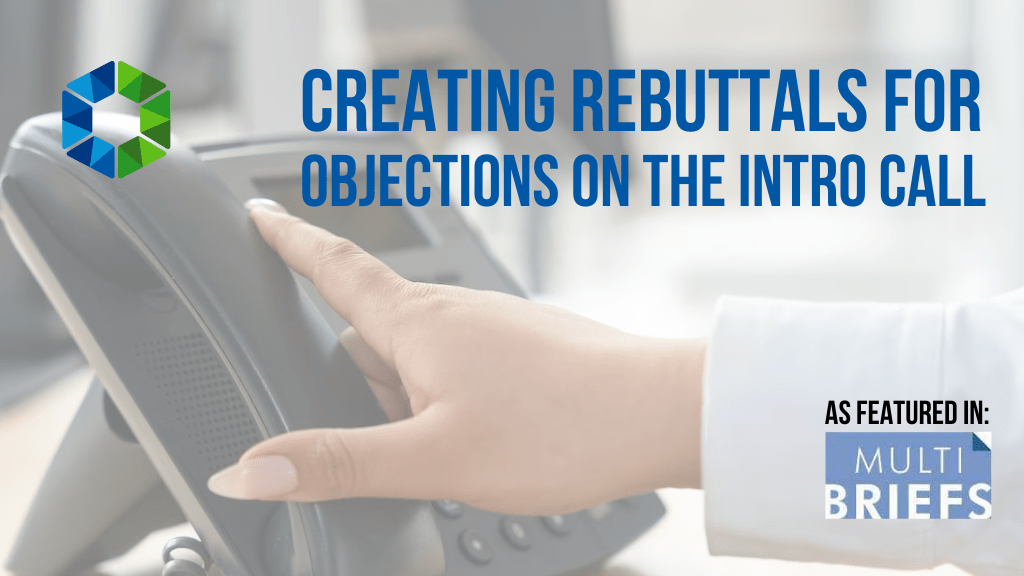
I Object! Creating Great Rebuttals for Those Pesky Objections on the Intro Call
Published in Multi-Briefs – Written by Amanda Puppo.
If you’re in sales, handling objections is part of the job. How do you get the conversation back on track, make that appointment or close that sale? Handling objections is one of the most important and difficult components to making the introductory call.
INDUSTRY PULSE
Which objection do you come across more often?
“I don’t have time to meet right now.”
“Send me something in the mail.”
Preparing for objections is essential; knowing how to respond is key. It is important to know how to answer the prospect with benefit statements and questions about your service that will uncover the true objection and present the value necessary to take the call to the next level. You’ve got to be fully prepared for their skepticism, as it goes with anything new.
An objection is a push back — a resistance to agreeing to your request — and it’s usually due to the prospect not fully understanding your value proposition. The “lowest price wins” mantra is often how deals are made. As salespeople, we’ve got to listen closely and read between the lines, to sell outside of price. Sell service now so that later, the next lowest-price competitor doesn’t win.
People will rarely jump into your arms in the first 30 seconds of a call and agree to whatever you are asking. If that happens, consider yourself lucky. You’ve just had excellent timing, and it may be a couple hundred introductory phone calls before you get that lucky again.
The good news is that there are only about 6-10 objections you will hear over and over again. It’s still a challenge to get to the “yes,” even if you master objection handling. But if you practice these techniques, you may get more appointments and sales this month than the previous month. Here are two objections you might hear frequently and some good rebuttals to get you started:
I don’t have time to meet with you right now.
Firstly, if “time” is the main objection, the prospect has not yet been sold on value. People make time for what they want to make time for. And everyone has 20 minutes to check out something that interests them. The question is, where are you on their priority list, and how can you develop rapport and get on their calendar? Build value in the mind of your prospect with your service: Be pleasant, professional and friendly, and you’ll be invited in. Are you able to show the prospect value through thought-provoking features and benefits, so that you move up the priority list?
Outside of building value, try this:
“I can certainly appreciate your time, and I often schedule several weeks out. Take a look at your calendar, and let’s pencil something in for next month, would the eighth or 21st work for you?”
If you are finding it difficult still to get the appointment, ask the prospect what month may be a better time to follow up. Then record good notes of what they said throughout the conversation and actually follow up. If the prospect feels no “pain,” then the “no time” objection may just be a cover for “This is not my priority because I’m not feeling any pain.”
Send me something in the mail.
Is this a brush-off or a genuine request for more information? Let’s get real — catalogs with this type of product all start to look the same. It’s service you are selling, so it’s possible they are just delaying the meeting. Try this response to find out:
“Mr. Prospect, I’m sure that price is important to you, as it is to all my clients. If we can meet for 20 minutes or so, I can learn a little about your business and come up with something that suits your needs and share the price that goes along with it. The brochure just presents a broad stroke on our services. Does that make sense?”
Now, of course, this rebuttal may seem idiosyncratic to the previous notion of not selling on price. However, you are simply trying to provide a rational rebuttal to the “send mail” objection. If the prospect insists on seeing information before meeting with you, make sure to get his or her permission to call back. Hold them accountable to review it and get a next step:
“After you’ve have a chance to look at the information, I’ll give you a call to see if you have any additional questions and perhaps at that time, we can consider a meeting. Will you be around Tuesday?”
Notice that every rebuttal ends in a question. If your goal is to get the appointment, ask the closing question wherever possible. However, before you can get to that closing question, be sure to ask the fact-finding questions to help you to learn more about your prospect and his or her business so that you can build rapport and become a trusted advisor for that company.
Amanda Puppo is the CEO of MarketReach Inc., providers of business-to-business outbound telephone marketing. Services include appointment setting, customer satisfaction surveys, database clean-up, client reactivation and introductory call training. Reach Amanda Puppo at Amanda@MarketReachResults.com, or call 609-448-6364, ext.100.

Comments are closed.